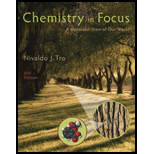
Interpretation:
The percent efficiency of the tower is to be calculated.
Concept Introduction:
Hundreds of sun-tracking mirrors, called heliostats, form a tower.
The percent efficiency of heliostats is given by:
Answer to Problem 10.1YT
Solution:
Explanation of Solution
Since the total power produced is
The conversion of kW into W is as follows:
Since the total number of heliostats is
Hence, the active area is
The solar energy falls on the active area at the rate of
Therefore, the input power is
The percent efficiency of heliostats is calculated as follows:
Substitute
The tower gives a percent efficiency of
Want to see more full solutions like this?
Chapter 10 Solutions
Chemistry In Focus
- The best solar panels currently available are about 15% efficient in converting sunlight to electricity. A typical home will use about 40. kWh of electricity per day (1 kWh = 1 kilowatt hour; 1kW = 1000 J/s). Assuming 8.0 hours of useful sunlight per day, calculate the minimum solar panel surface area necessary to provide all of a typical homes electricity. (See Exercise 124 for the energy rate supplied by the sun.)arrow_forwardSome solar-heated homes use large beds of rocks to store heat. (a) How much heat is absorbed by 100.0 kg of rocks if their temperature increases by 12C? (Assume that c=0.82J/gC.) (b) Assume that the rock pile has total surface area 2 m2. At maximum intensity near the earth's surface, solar power is about 170 watts/m2. (1watt=1J/s.) How many minutes will it take for solar power to produce the 12C increase in part (a)?arrow_forwardExplain why hydroelectric power and wind power are indirect forms of solar energy.arrow_forward
- Define the terms renewable and nonrenewable as applied to energy resources. Which of the following energy resources are renewable: solar energy, coal, natural gas, geothermal energy, wind power?arrow_forwardCalculating Energy Use in Kilowatt-Hours What is the yearly cost of operating a 100-W television for 2 hours per day, assuming the cost of electricity is 15 cents per kilowatt-hour?arrow_forwardExplain why oceanfront areas generally have smaller temperature fluctuations than inland areas.arrow_forward

 Chemistry & Chemical ReactivityChemistryISBN:9781133949640Author:John C. Kotz, Paul M. Treichel, John Townsend, David TreichelPublisher:Cengage Learning
Chemistry & Chemical ReactivityChemistryISBN:9781133949640Author:John C. Kotz, Paul M. Treichel, John Townsend, David TreichelPublisher:Cengage Learning Chemistry & Chemical ReactivityChemistryISBN:9781337399074Author:John C. Kotz, Paul M. Treichel, John Townsend, David TreichelPublisher:Cengage Learning
Chemistry & Chemical ReactivityChemistryISBN:9781337399074Author:John C. Kotz, Paul M. Treichel, John Townsend, David TreichelPublisher:Cengage Learning
 ChemistryChemistryISBN:9781305957404Author:Steven S. Zumdahl, Susan A. Zumdahl, Donald J. DeCostePublisher:Cengage Learning
ChemistryChemistryISBN:9781305957404Author:Steven S. Zumdahl, Susan A. Zumdahl, Donald J. DeCostePublisher:Cengage Learning Chemistry: An Atoms First ApproachChemistryISBN:9781305079243Author:Steven S. Zumdahl, Susan A. ZumdahlPublisher:Cengage Learning
Chemistry: An Atoms First ApproachChemistryISBN:9781305079243Author:Steven S. Zumdahl, Susan A. ZumdahlPublisher:Cengage Learning





